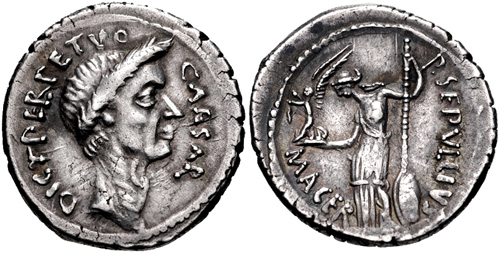The coin that most likely got Julius Caesar assassinated.

Photo Courtesy of Classical Numismatics Group
It’s the dawn of the Ides of March. The most popular consul, Julius Caesar, makes his routine walk through the Roman forum up to the senate building. He has little idea what awaits him. This is a day that will be described in literature and tale for the next two thousand years. A day that will inspire poets, storytellers, and historians alike. A day that will live in infamy.
Julius Caesar came from a familial-rich background. The family name had been present in elections, office, and coinage before Caesar was born. He is historically most famous for his successful military campaigns, where he contributed to the vast expanse of the Roman Republic and allowed for the flow of wealth and prosperity to its peoples. His influence on the people of Rome is undebatable, and he continued to campaign (only politically) in his later years as Senate Consul, then Dictator for life.
Many historians debate on the true reason Caesar was killed by his own senators. The socioeconomic factors regarding the sudden consulship of Caesar are perhaps the reason he was popular with the populace and not the senate. He strived for power and influence which was an ideal the Senate reserved for the whole of the government and not a single individual. The Consul’s were seen as leaders and chairmen and were elected by special election. Caesar soon declared himself dictator, and ultimately, a series of events called the “three last straws” contributed to his demise. His primary concern seemed to be unconditional leadership of Rome—a Republic that predominantly was controlled by the masses in a senate. Perhaps the senate believed that Caesar’s extended consulship would lead him to directly overthrow the senate. Brutus and Cassius were driven by this factor, so were the other forty Roman senators.
Crassus, the moneyer during the dominion of Caesar, kept the production and regulation of coinage in line. Coinage had become a form of advertising and demonstration of wealth for powerful families and moneyers. It was also used as a form of propaganda, where moneyers would issue coins with important family names or images such as Victory and Prosperity. Legionnaires were paid via their general, who would issue coins in a walking military mint. The most notable of these include the Denarii and Aurei minted by Caesar and Marc Antony during their campaigns. A legionnaire was paid a Denarius a day, and officers were paid in small gold Aurei (later being paid in Medallions depending on servitude and rank). Caesar’s earliest coins featured an elephant with CAESAR written below, in his Northern campaigns. Other coins were minted with portraits of Venus during his African campaigns. In the dawn of February 44 BC, Caesar issued his most controversial coin. This coin, minted by the moneyers Aemilius Buca and Sepullius Macer, was one of the first coins in the Republic to feature a portrait of a living individual. It was very unpopular, primarily due to the legend, and gave people the false impression Caesar was declaring himself a god-like leader. The senate approved this coinage design upon Caesar’s fourth consulship, and was a sudden break in tradition. The legend, reading “dictator for life” (dictator perpetuo) was an indirect declaration of war, as a dictator for life would mean unraveling the previous way of Republican life. The coins were issued for a miniscule two months from February-March 44 BC before his death.


Denarius of Caesar reading DICTATOR PERPETUO “dictator for life” minted 44 BC
Ironically, as soon as civil war broke out in Rome, Caesar’s successors adopted a similar process of minting coins with their portrait. Marc Antony, Octavian, and Brutus (all involved in this first Roman Civil War) issued coins in their walking military mint. It is important to know consuls had placed their portrait on coins before and after Caesar, such as Marcius Philippus who minted coins with his portrait during his consulship in 56 BC. The transition from the Republic to Empire ensured that this process would stay permanent, and was quite the opposite as the old process. Emperors would approve designs and moneyers were placed in established mints across the empire. Coins were issued only with the portrait of the reigning emperor, and were only minted without his portrait to commemorate a subject or event.


Denarius of Marcius Philippus minted around 57 BC (after his death)
Following the assassination of Julius Caesar, Brutus, one of the chief conspirators, played a prominent role in the political aftermath. As part of his efforts to gain support and legitimacy for the act of regicide, Brutus authorized the minting of Denarii bearing his name and likeness. These coins served as a means to propagate the ideals of liberty and the restoration of the Roman Republic. The Ides of March denarius minted by Brutus represents a bold statement against Caesar's perceived tyranny, reflecting the complexities and intense political atmosphere of ancient Rome during this tumultuous period. They feature two daggers and a cap, a way for Brutus to bluster his involvement in Caesar’s killing. The fierce portrait of Brutus appears on both silver and gold issues minted during the civil war.

Denarius of Brutus minted around 42 BC commemorating the death of Caesar
The coins of Julius Caesar, particularly the Ides of March denarii, embody the pivotal period in Roman history when the Republic gave way to the Empire. These coins not only served as a medium of exchange but also reflected the political ambitions and propaganda efforts of Caesar himself. The issuance of coins with his own image symbolized the changing power dynamics in Rome and set the foundation for the emergence of a centralized imperial rule. The coins of Julius Caesar stand as tangible artifacts that mark the transformative transition from the Roman Republic to the Roman Empire, forever leaving an indelible mark on the course of Western civilization.
Article By. Colby J. Abele

